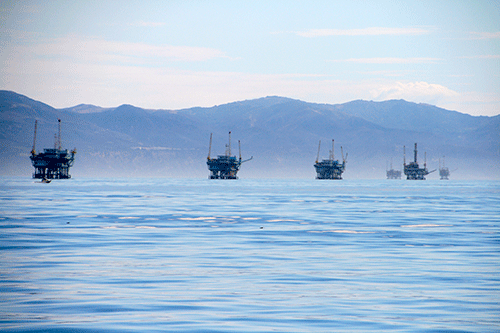Environmental Group Gains Protections From Offshore Fracking
SETTLEMENT WILL REQUIRE FIRST EVER ENVIRONMENTAL ANALYSIS OF FRACKING AND ACIDIZING
IN FEDERAL WATERS OFFSHORE CALIFORNIA
Santa Barbara— Today the Environmental Defense Center (“EDC”) announced a settlement agreement requiring federal agencies to conduct a comprehensive environmental review of oil drilling permits authorizing the use of well stimulation, including acidizing and hydraulic fracturing (“fracking”), from oil platforms off California’s coast. Offshore fracking and acidizing have so far been conducted in federal waters without any prior environmental analysis or public transparency.
 Today’s settlement agreement has been submitted and must be reviewed by a federal judge for final approval. If approved, this would mark the first time anywhere in the nation that the two relevant agencies, Bureau of Safety and Environmental Enforcement (“BSEE”) and Bureau of Ocean Energy Management (“BOEM”), will be required to evaluate the significant risks that these practices pose to water and air quality and the many endangered species within the Santa Barbara Channel, including blue, fin, and humpback whales, and the southern sea otter.
Today’s settlement agreement has been submitted and must be reviewed by a federal judge for final approval. If approved, this would mark the first time anywhere in the nation that the two relevant agencies, Bureau of Safety and Environmental Enforcement (“BSEE”) and Bureau of Ocean Energy Management (“BOEM”), will be required to evaluate the significant risks that these practices pose to water and air quality and the many endangered species within the Santa Barbara Channel, including blue, fin, and humpback whales, and the southern sea otter.
“This settlement is an important first step in addressing the use of dangerous well stimulation techniques including fracking and acidizing from oil platforms located off California’s coastline,” said Brian Segee, Senior Attorney with EDC. “These practices are currently being conducted under decades old plans with out-of-date or nonexistent environmental analysis, and this settlement will finally force the federal government to consider their impacts in detail with a transparent process open to public review and input.”
The use of offshore well stimulation methods in California was largely unknown until 2013, when EDC and news organizations discovered the use of such methods through the Freedom of Information Act (“FOIA”). Prior to filing the first ever law suit on this issue, EDC published a report, entitled Dirty Water: Fracking Offshore California, which documented more than a dozen instances of fracking from oil platforms within the Santa Barbara Channel. EDC’s report not only identified where and over what period fracking had been conducted in the Channel, but also outlined policy recommendations including some similar to the outcome of today’s settlement announcement.
Documents obtained through EDC’s FOIA requests demonstrated that regulators with BSEE and BOEM were largely unaware of offshore fracking, and did not know where or how frequently the practice had been used. Nonetheless, the agencies continued to approve drilling permits authorizing offshore well stimulation without any environmental analysis, and EDC has had to submit additional FOIA requests to obtain the drilling permits at issue in the lawsuit.
Under the settlement, BOEM and BSEE have committed to take the following actions:
- Prepare a “programmatic Environmental Assessment” (“PEA”) pursuant to the National Environmental Policy Act addressing environmental impacts of offshore well stimulation in federal waters off California. The agencies must issue the environmental review document by May 28, 2016, after a public comment period of at least 30 days.
- Pending completion of the PEA, the agencies will withhold approval of drilling permits authorizing well stimulation.
- If the agencies determine that well stimulation may have significant environmental impacts during the PEA process, then they must conduct more robust environmental review, in the form of a Programmatic Environmental Impact Statement.
- BSEE will develop an electronic filing and public notification web site for offshore drilling permit applications, and post completed applications to the system within five days. Unlike offshore oil drilling in the Gulf of Mexico, there is currently no public notification regarding oil drilling permits issued for drilling conducted offshore California.
In total, EDC’s case challenged the issuance of 53 permits authorizing offshore well stimulation from six offshore platforms. Two of these platforms (Gail, Gilda) are located off Ventura County and the remaining four platforms (Harmony, Heritage, Hondo, and Irene) are located off Santa Barbara County. Platforms Harmony, Heritage, and Hondo are owned and operated by ExxonMobil, and oil from those platforms feeds into Plains All American Pipeline 901, which burst last year near Refugio State Beach, releasing hundreds of thousands of gallons of oil into the local environment.
The settlement can be viewed here.
###
Environmental Defense Center, a non-profit law firm, protects and enhances the local environment through education, advocacy, and legal action and works primarily within Ventura, Santa Barbara, and San Luis Obispo Counties. Founded in response to the 1969 Oil Spill more than 40 years ago, EDC has represented itself and other organizations to advance environmental protection. Program areas include protecting coast and ocean resources, open spaces and wildlife, and human and environmental health. Learn more about EDC at www.EnvironmentalDefenseCenter.org.





